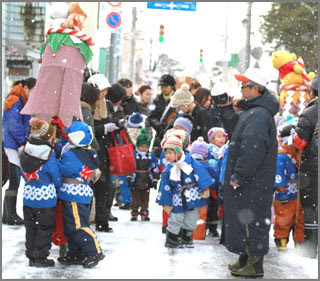:::::::::::::::::::::::::::::::::::::::::::::::::::::::::::::::::::::::::::::::::::::::::::::::::::::::::::::::::::::::::::::::::::::::::::::::::::::::::::::::::::::::::::
| Otakapoppo おたかぽっぽ / お鷹ぽっぽ toy hawk O-Taka Poppo, Otaka poppo From Yonezawa, Yamagata  The word poppo is a local dialect for toy. He is an amulet for the good fortunes of the family (kaun, ka-un takamori 家運隆盛) This toy has a long tradition of more than 200 years. It dates back to the 9th Daimyo of the town Yonezawa, Uesugi Yoozan 上杉鷹山公 (Uesugi Yozan). He had it made by the farmers in winter, when they could not go out. It soon became a source of income for them. Today it is one of the most popular souvenirs of Yonezawa. Lord Yozan took the Chinese character for hawk, taka, as part of his name to honor the strength of this animal, and to ensure its protection from evil for himself and his people. Each toy is carved from one piece of wood and the tail is especially carefully carved. Special knives are used to carve the tail. sarukiri サルキリ chijire チヂレ  :::::::::::::::::::::::::::::::::::::::::::::::::::::::::::::::::::::::::::::::::::::::::::::::::::::::::::::::::::::::::::::::::::::::::::::::::::::::::::::::::::::::::::  source : popyah/yamagata There are many samples in the regional folk museum of Yonezawa. . . . . . There is also a huge statue in front of the temple Sasano Kannon 笹野観音  This temple of Shingon Buddhism has been constructed around 810. Its main deity is a Kannon Bosatsu with 1000 arms and 1000 eyes. 千手千眼観世音菩薩  The statue is flanced by Jizo Bosatsu and Bishamonten. http://sasanokannon.com/ This temple celebrates a special fire purification winter ritual on January 17. Hatsu Ju-shichi-do Matsuri 十七堂祭り Cooked radish and sweet sake are distributed. There are also stalls selling traditional arts and crafts including Sasano Ittobori wood carvings. Saito Goma 柴燈護摩のご祈祷 page with photos: http://sasanokannon.com/17dou.html :::::::::::::::::::::::::::::::::::::::::::::::::::::::::::::::::::::::::::::::::::::::::::::::::::::::::::::::::::::::::::::::::::::::::::::::::::::::::::::::::::::::::::  Uesugi Yoozan 上杉鷹山公 Uesugi Yozan (1751 - 1822) He founded the domain school . Koojookan 興譲館 Kojokan . in Yonezawa. He is very famous, there are many books and novels about him.  Statue of Lord Yozan one of his famous quotes Do and it will be done; don’t do and it will not be done: if something is not done, that is because no one did it. 為せば成る、為さねば成らぬ何事も、 成らぬは人の為さぬなりけり。 . Reference . Uesugi Yozan Harunori :::::::::::::::::::::::::::::::::::::::::::::::::::::::::::::::::::::::::::::::::::::::::::::::::::::::::::::::::::::::::::::::::::::::::::::::::::::::::::::::::::::::::::  Sasano ittoobori 笹野一刀彫 Sasano Ittobori carvings with one knife  - ebay 2015 - .......................................................................................................................................................... Sasano Ittoobori Daruma 笹野一刀彫達磨 Sasano Daruma   from the Shimazu Collection 島津コレクション source : syumi-uu . tora 寅 / トラ tiger - from Yamagata . :::::::::::::::::::::::::::::::::::::::::::::::::::::::::::::::::::::::::::::::::::::::::::::::::::::::::::::::::::::::::::::::::::::::::::::::::::::::::::::::::::::::::::  . . . CLICK here for Photos ! . Reference . ::::::::::::::::::::::::::::::::::::::::::::::::::::::::::::::::::::::::::::::::::::::::::::::::::::::::::::::::::::::::::::::::::::::::::::::::::::::::::::::::::::::::::: 軒氷柱お鷹ポッポの鋭き視線 noki tsurara otaka poppo no eiki shisen icicles on the eaves - the spirited glare of Otakapoppo Nakada Nobuko 中田のぶ子 . WKD : Hawk (taka) ::::::::::::::::::::::::::::::::::::::::::::::::::::::::::::::::::::::::::::::::::::::::::::::::::::::::::::::::::::::::::::::::::::::::::::::::::::::::::::::::::::::::::: Sanriku coast - a hawk soars high above the rubble . Japan after the BIG earthquake March 11, 2011  source : www.47news.jp Miyagi Prefecture, Minami Sanriku Town 宮城県南三陸町 March 11, 2011 |
:::::::::::::::::::::::::::::::::::::::::::::::::::::::::::::::::::::::::::::::::::::::::::::::::::::::::::::::::::::::::::::::::::::::::::::::::::::::::::::::::::::::::::
[ . BACK to WORLDKIGO . TOP . ]
[ . BACK to DARUMA MUSEUM TOP . ]
:::::::::::::::::::::::::::::::::::::::::::::::::::::::::::::::::::::::::::::::::::::::::::::::::::::::::::::::::::::::::::::::::::::::::::::::::::::::::::::::::::::::::::







































